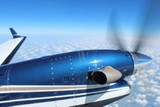
Some pilots can live on this job. Others do only four to six ferry flights a year – like we do. And there are hundreds of pilots dreaming of a North Atlantic crossing once in their life. But, if not prepared carefully and correctly, a ferry flight is a dangerous business. On the other hand, if you are an experienced pilot who knows his aircraft and his route, you can really enjoy these trips.
We started to plan our ferry from Wichita, Kansas where Beechcraft Corp. is based, to Germany some weeks before our departure. Plenty of time. Our brand new King Air 350i was registered under a permit to fly.
Beside a few additional details, you need to have an entry, or over-flight-permit, for each country which you are crossing. This time we asked HQ Flight Operations to request these permits. They have done several hassle-free flight preparations for us before.
We have taken on the planning along the flight route, the hotels, and FBOs. For the route preparations and flight plan filing, we use Euro FPL, which is an excellent system.
Our journey started on 17th of August on Munich airport where we booked a flight with United Airlines via Chicago, Illinois to Wichita, Kansas.
In Chicago we had a stop of 2:30pm. Plenty of time? Not really. The immigration procedure takes about 90 minutes. If you finally have the immigration allowance, you can pick up your baggage and check it in for the connecting flight. We reached our next terminal by airport train where we had to pass through the security checks again. We arrived at our gate 20 minutes before boarding. Very close.
The next morning, Rich, the project director of Beechcraft Corp., met us in the hotel lobby and took us to Jabara airport.
The aircraft looked great! Imagine a new Beechcraft King Air 350i painted white with metallic blue and golden stripes! Our temporary call sign: D-CFMU.
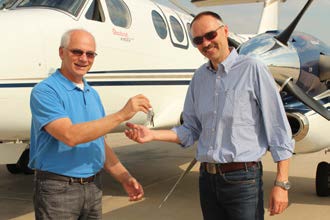 Everything was perfectly prepared for our Sunday take off. The aircraft was fully fueled, catering was on board and documents were in place. After completion of our preflight inspection we were ready before our intended take off time of 11:00am local time.
Everything was perfectly prepared for our Sunday take off. The aircraft was fully fueled, catering was on board and documents were in place. After completion of our preflight inspection we were ready before our intended take off time of 11:00am local time.
Our weather forecast: VMC, some clouds in the east. We expected few clouds in 5000 ft at our destination, Scranton, Pennsylvania. About 4 hours to fly.
Clearance delivery allowed us to start the engines. Jabara has no tower so after receiving the release from Wichita approach, we just called unicom to tell the other traffic what we intend to do. After departure on runway 18, we followed a left turn to heading 090 and climb to 3000 feet.
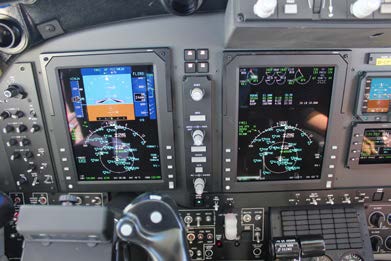 Shortly after take-off we received the clearance to ROKNE, our first fix on the route. Climb up to 15.000 feet not FL150. The transition altitude in the United States is 18.000 ft, in Germany it is 5000 feet. Our final level was FL 280. With 65% power and 1500 RPM of the propellers our cruise speed was 292 KTAS with ISA +8°C. The Collins Proline 21 avionics is showing everything you need: SAT -32° C, 292 KTAS, 186 KIAS and much more. An excellent system as soon as you are familiar with it.
Shortly after take-off we received the clearance to ROKNE, our first fix on the route. Climb up to 15.000 feet not FL150. The transition altitude in the United States is 18.000 ft, in Germany it is 5000 feet. Our final level was FL 280. With 65% power and 1500 RPM of the propellers our cruise speed was 292 KTAS with ISA +8°C. The Collins Proline 21 avionics is showing everything you need: SAT -32° C, 292 KTAS, 186 KIAS and much more. An excellent system as soon as you are familiar with it.
During the flight we have been handed over from one radio station to the next: Wichita approach, Kansas City Center, Indianapolis Center, Cleveland Center, New York Center and so on. A German call sign starting with the “D” is not so common here in the US. So they called us “King Air DCFMU” or “DCFMU” or just “FMU”.
 During the flight, we occasionally flew on top of clouds and sometimes had a perfect view of various cities. A part of the approach was performed in IMC. The weather at our destination in Scranton (Wilkes-Barre KAVP), was broken in 3500 ft and overcast in 4400 ft with a temperature of 24° C (75 F). Our flight time was 3:47 in FL280. The aircraft worked well with all systems running smoothly. Even the chart update was done for our flight.
During the flight, we occasionally flew on top of clouds and sometimes had a perfect view of various cities. A part of the approach was performed in IMC. The weather at our destination in Scranton (Wilkes-Barre KAVP), was broken in 3500 ft and overcast in 4400 ft with a temperature of 24° C (75 F). Our flight time was 3:47 in FL280. The aircraft worked well with all systems running smoothly. Even the chart update was done for our flight.
On Monday, the 19th of August, we were cleared to go after calling Canadian customs, and having passed US customs. The wind was calm with very good visibility and 20 ° C (68 F). For our trip we expected to have some clouds and wind from the West with about 50 knots and later from North West with 15 to 35 knots.
The departure was a simple Scranton 4 C departure, which is “climb on runway track to 5000 ft. Thereafter radar vectors to the first fix”: Lake Henry VOR. Flying in this area demands to know the full names of the VORs because you will get the clearance to Lake Henry VOR instead of LHY VOR, initially. Soon after departure we got the clearance to climb up to level 180, later up to level 270, our final level for the day.
The engines of the King Air 350i are Pratt & Whitney Canada PT6A-60A’s producing up to 1050 hp each side. During normal operation it is very simple to operate these engines within the allowed limitations. It is much more complicated to handle a piston engine of a Beechcraft Bonanza or the geared engines of a Cessna 421C for example.
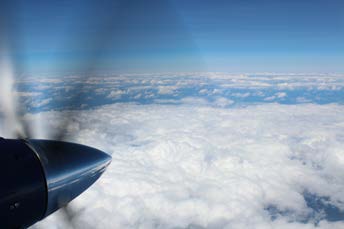
The routing to Goose Bay was nearly a straight line with having 3 VORs as waypoints.Unfortunately, the visibility was not the best. We had some haze and clouds below while flying in the sun most of the time. What we saw from the ground was mainly forest. There were wide areas on our way with a very low population.
After sitting for about 3 hours on such a straight and level flight, we begain preparing for the Goose Bay approach which one cannot miss the variation of 24 deg. The ATIS informed us to expect the ILS 08 with overcast clouds at 2900 ft and 15 miles visibility. On ground there is a temperature of 11 ° C (51 F) with a dew point of 6° C (42 F).
Here at Goose Bay, the Germans and Britain used to have a military base but both left some years ago. The area around the airport is a bit bleakly. The driver who took us to the hotel was a former fisher. The government forced the citizens of his home town to move. Fishing was forbidden in that area so the fisher had to go. He was working at the airport of Goose Bay for 4 years, but was still unhappy. He was missing the sea.
It was interesting that I have had about 20 overnight stops here but I know only the area around the airfield. I wish I could explore more of the fantastic scenery of Labrador! The next day we had to start early in the morning as we planned to fly via Narsarsuaq in Greenland to Keflavik, Iceland, which was two 3 hour trips. Next morning we woke up very early, 4:30am. It was still dark outside but a star-bright morning showed us the Great Bear in the sky.
The weather was decent and we planned to fly at FL270 with a true airspeed of 260 knots. We expected wind from the North with 70 knots at the beginning changing to 25 knots from South West. Flight time of about 2:30 to Narsarsuaq. The weather for the flight to Iceland was good as well. If the wind stays as forecasted, we had hoped to go direct to Iceland.
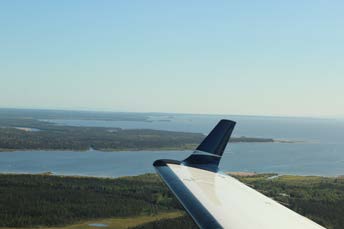 After refueling the aircraft we were ready to go in time. Take off at runway 34 and cleared direct LOACH very soon we saw the very beautiful landscape of Labrador. In order to save time and fuel, we had to climb. We reached our cruise altitude of FL270 (27.000 ft) 15 minutes after take-off.
After refueling the aircraft we were ready to go in time. Take off at runway 34 and cleared direct LOACH very soon we saw the very beautiful landscape of Labrador. In order to save time and fuel, we had to climb. We reached our cruise altitude of FL270 (27.000 ft) 15 minutes after take-off.
Loach is already 50NM away from the coastline. Here we were already handed over to Gander Radio. The necessary position report over the ocean is: overhead LOACH 1319 FL270, estimate 59N50W at 1450, next SI. We received the frequency to call at the next fix with the statement that we will be out of VHF coverage in about 20 minutes.
From here forward, one can see water and some clouds. That’s it for the next 2 hours. On COM2 we selected the emergency frequency. We did not plan to use it but it’s good to listen, if someone else needs assistance.
During the flight we changed our plan and continued to Keflavik. Gander Radio gave us the clearance on request. Greenland was mostly covered with clouds so this time we hadn’t seen much of the beautiful landscape. East of Greenland the top of clouds were initially close to FL270, which was our cruising altitude. Later we flew in clouds for some time.
Keflavik ATIS: Runway 02, wind 090 with 4 knots, visibility more than 10 km, few clouds in 2500 ft, broken in 4000 ft, temperature 10, dew point 4, QNH 1012, transition level 75. At this time, we changed our altimeter setting from inches to hPa. Very simple with the Proline 21.
We choose the ILS02 at the FMS about 40 minutes prior arrival. 100 NM before reaching our initial approach fix, we started the descent with selecting the VNAV mode vertical path. This is a continuous descent to the initial approach fix. Coming closer to Iceland we saw the country in a wonderful light. The sun was low, and the visibility amazing.
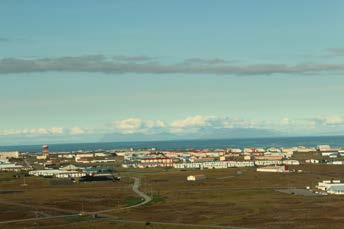 It was a nice and smooth landing and a perfect end of this flying day after 5:12 hours flight time.
It was a nice and smooth landing and a perfect end of this flying day after 5:12 hours flight time.
The hotel in Keflavik is situated close to the coastline where we went to enjoy the beautiful light and took some photos. Next morning, Keflavik showed us a different side of the country – rain. The weather to Glasgow was cloudy but we had some good tailwind. During our departure, we hadn’t seen Iceland. Climbing to FL270 we saw that the tops of the clouds where at FL160. Our cruise speed was 260 knots true airspeed, again. The routing of our 770 NM trip was OSKUM at the coastline to RATSU and further over to Stornoway in a straight line to the intersection LAGAV. Then southbound to Glasgow VOR where we expected an ILS 23 to land.
100 NM south of Iceland, the cloud base changed from overcast to broken and we could see the sea. The next coastline is the island Stornoway approx. 350 NM in front of us.
After a smooth landing at Glasgow International Airport we were received by our handling agent. He had already prepared the customs documents. Shortly after refueling we took off to our final destination in Northern Germany.
The initially cleared TLA5A departure from runway 23 was a bit cutted by radar vectors because a Boeing 737 started just behind us. Soon after departure, we were cleared to FL270, our final level on the way to our destination in Northern Germany. The expected flight time was about 2 hours. We could make it from Keflavik to our final destination but we had to leave the life raft in Glasgow, which we borrowed from a friend in Scranton.
Our routing was along the east coast of Great Britain. Soon we got some shortcuts and had about 120 NM over the sea to the coastline of the Netherlands. The direct visual approach to our final destination went well. We had CAVOK with nearly no wind. After our landing we were welcomed by our customer and an employee of Beechcraft.
All together we had a flight time of 19:27 for this 4830 NM trip while burning 1360 USG/ 5165 Ltr of Jet fuel.
For the handover of this aircraft to our customer, we prepared a list of the items which should be corrected. This was the shortest list in my live after such a ferry. This Beechcraft King Air 350i is a great airplane and I congratulate the new owner on this excellent aircraft. May he always have happy landings with it!

About the Author
 Klaus Kuehl is the owner of German aircraft trading company K-Aircraft Jets & Props. The company has been engaged in aircraft trading since 1993, successfully operating our own business since 2003. They have tons of experience in buying and selling aircraft. More information at www.k-aircraft.de.
Klaus Kuehl is the owner of German aircraft trading company K-Aircraft Jets & Props. The company has been engaged in aircraft trading since 1993, successfully operating our own business since 2003. They have tons of experience in buying and selling aircraft. More information at www.k-aircraft.de.

